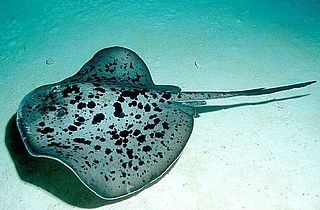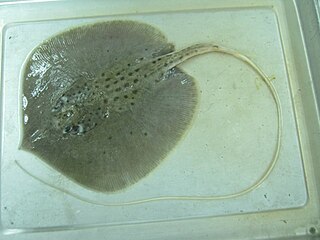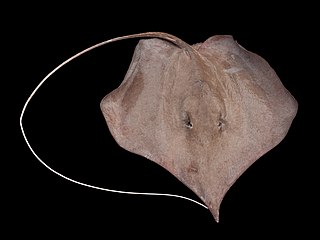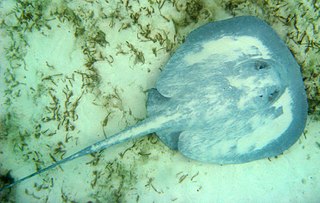
Dasyatis is a genus of stingray in the family Dasyatidae that is native to the Atlantic, including the Mediterranean. In a 2016 taxonomic revision, many of the species formerly assigned to Dasyatis were reassigned to other genera.

Himantura is a genus of stingray in the family Dasyatidae that is native to the Indo-Pacific. In a 2016 taxonomic revision, many of the species formerly assigned to Himantura were reassigned to other genera.

Urogymnus is a genus of stingrays in the family Dasyatidae from marine, brackish and freshwater habitats in the Indo-Pacific and tropical East Atlantic regions. The genus was previously considered to be monotypic, containing only the porcupine ray. Molecular phylogenetic research published in 2016 reassigned several species from Himantura to Urogymnus.

The whiptail stingrays are a family, the Dasyatidae, of rays in the order Myliobatiformes. They are found worldwide in tropical to temperate marine waters, and a number of species have also penetrated into fresh water in Africa, Asia, and Australia. Members of this family have flattened pectoral fin discs that range from oval to diamond-like in shape. Their common name comes from their whip-like tails, which are much longer than the disc and lack dorsal and caudal fins. All whiptail stingrays, except the porcupine ray, have one or more venomous stings near the base of the tail, which is used in defense. They range in size from 0.18 to 2.0 m or more across in the case of the smalleye stingray and giant freshwater stingray.

Taeniura is a genus of stingrays in the family Dasyatidae. The species Taeniurops grabata and T. meyeni were formerly placed in this genus. However, phylogenetic research has shown that these two species are not closely related to T. lymma, and they have been assigned to a separate genus, Taeniurops.
The smalleye whip ray is an obscure species of stingray in the family Dasyatidae. It is known only from a single specimen collected off Taiwan and assigned to the genus Dasyatis by J.T.F. Chen in 1948. In 1982, Leonard Compagno and Tyson Roberts moved it to the genus Himantura based on its apparent lack of a tail fold. In 2006, B. Mabel Manjaji-Matsumoto and Peter Last determined that the type specimen had been lost since Chen's description and that no further specimens have emerged since. Therefore, they considered this species to be a nomen dubium, perhaps conspecific with Dasyatis acutirostra.
The Hortle's whipray is a little-known species of stingray in the family Dasyatidae, occurring in shallow estuaries and mud flats off southern New Guinea. This species, growing to 71 cm (28 in) across, has a heart-shaped pectoral fin disc with a long, pointed snout and minute eyes. It has a wide dorsal band of dermal denticles extending from in front of the eyes to the tail, as well as scattered sharp denticles on the snout. The underside of the disc is a distinctive bright yellow in color, sometimes with darker markings around the nostrils, mouth, and gill slits. The Hortle's whipray is threatened by extensive seine fisheries and habitat degradation, leading the International Union for Conservation of Nature (IUCN) to assess it as Near Threatened.

Taeniurops is a genus of stingrays in the family Dasyatidae. Its two species were formerly contained within the genus Taeniura.

Bathytoshia is a genus of stingrays in the family Dasyatidae found worldwide in tropical and warm temperate oceans. It was formerly regarded as a junior synonym of the genus Dasyatis.

Hemitrygon is a genus of stingrays in the family Dasyatidae from marine, brackish and freshwater habitats in the central Indo-Pacific and northwest Pacific regions. The genus was formerly regarded as a junior synonym of the genus Dasyatis.

Hypanus is a genus of stingrays in the family Dasyatidae from warmer parts of the East Pacific and Atlantic, including the Caribbean and Gulf of Mexico. The genus was previous regarded as a junior synonym of the genus Dasyatis.

Telatrygon is a genus of stingrays in the family Dasyatidae from the central Indo-Pacific. Its species were formerly contained within the genus Dasyatis.

Brevitrygon is a genus of stingrays in the family Dasyatidae from the Indo-Pacific. Its species were formerly contained within the genus Himantura.

Fluvitrygon is a genus of stingrays in the family Dasyatidae from freshwater in southeast Asia. Its species were formerly contained within the genus Himantura.

Fontitrygon is a genus of stingrays in the family Dasyatidae found in coastal tropical Atlantic waters and rivers that drain into the Atlantic. Fontitrygon species were formerly contained within the genus Dasyatis.

Maculabatis is a genus of stingrays in the family Dasyatidae from the Indo-Pacific. Its species were formerly contained within the genus Himantura.

Styracura is a genus of stingray in the family Potamotrygonidae and the only genus in the subfamily Styracurinae. The two species in this genus were formerly included in Himantura, but were moved to Styracura in 2016 based on morphology and molecular evidence. Unlike other members of the family Potamotrygonidae, also known as freshwater stingrays, Styracura are found in the tropical West Atlantic and East Pacific.
Maculabatis arabica, the Arabic whipray, is a species of stingray in the family Dasyatidae. It is found in the Indian Ocean: around Pakistan and India, and also found in the Arabian Sea. This species reaches a length of 45 cm (18 in).
Maculabatis bineeshi, the short-tail whipray, is a species of stingray in the family Dasyatidae. It is found in the Indian Ocean: around Pakistan and India, also in the Bay of Bengal. This species reaches a length of 66 cm (26 in).
The Arabian banded whipray, is a species of stingray in the family Dasyatidae. It is native to the Persian Gulf. It reaches a length of 41.2 cm (16.2 in).















